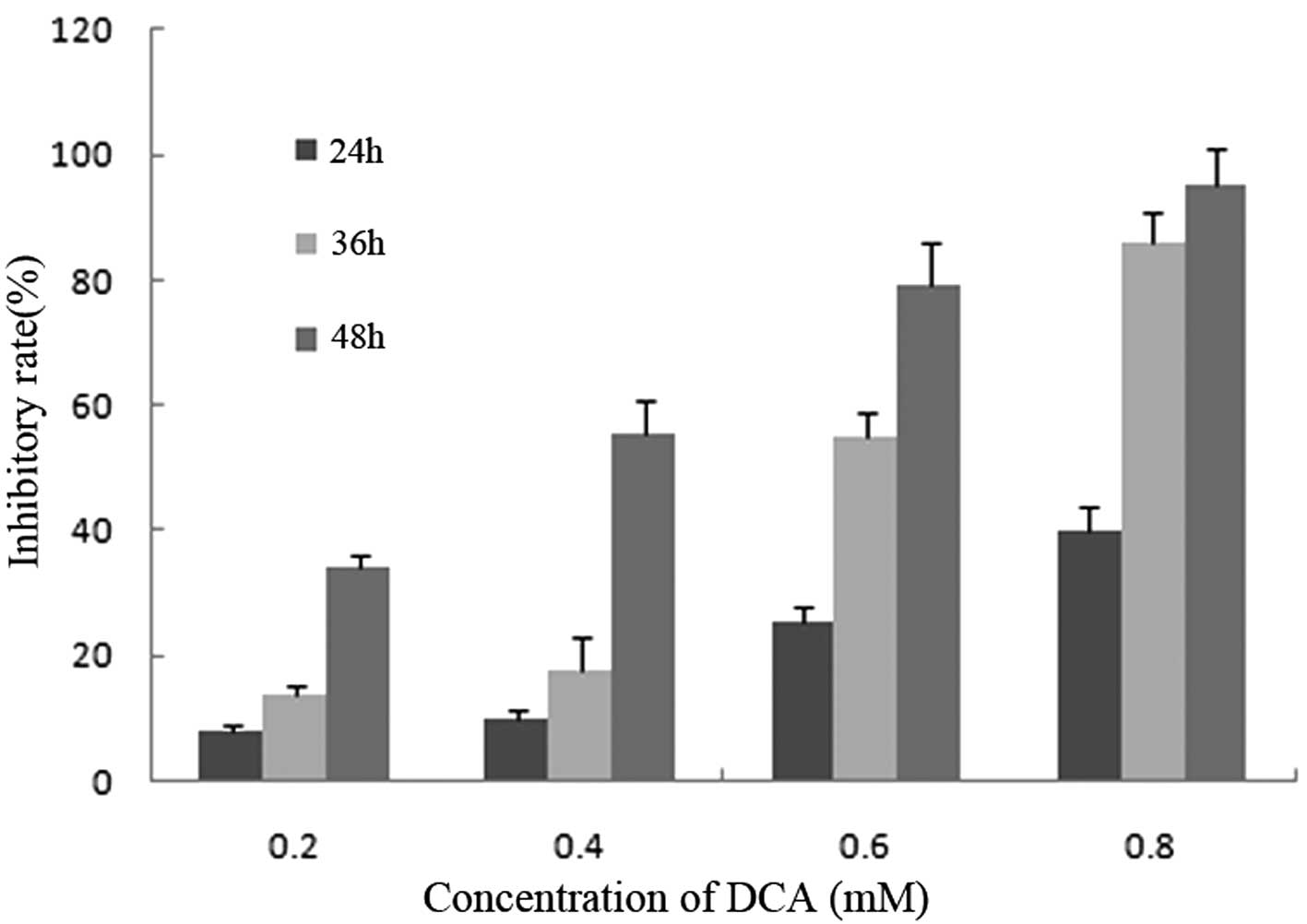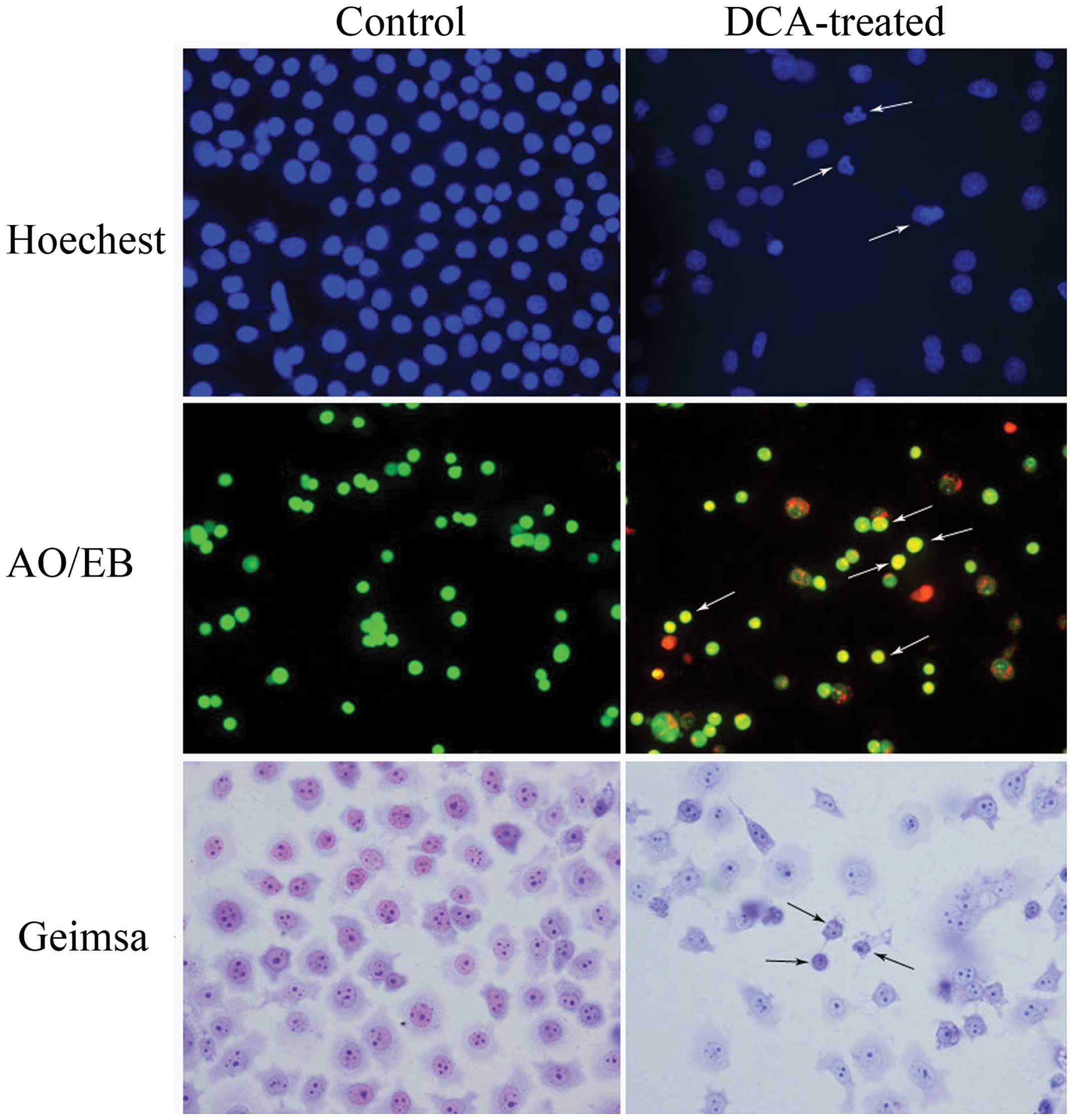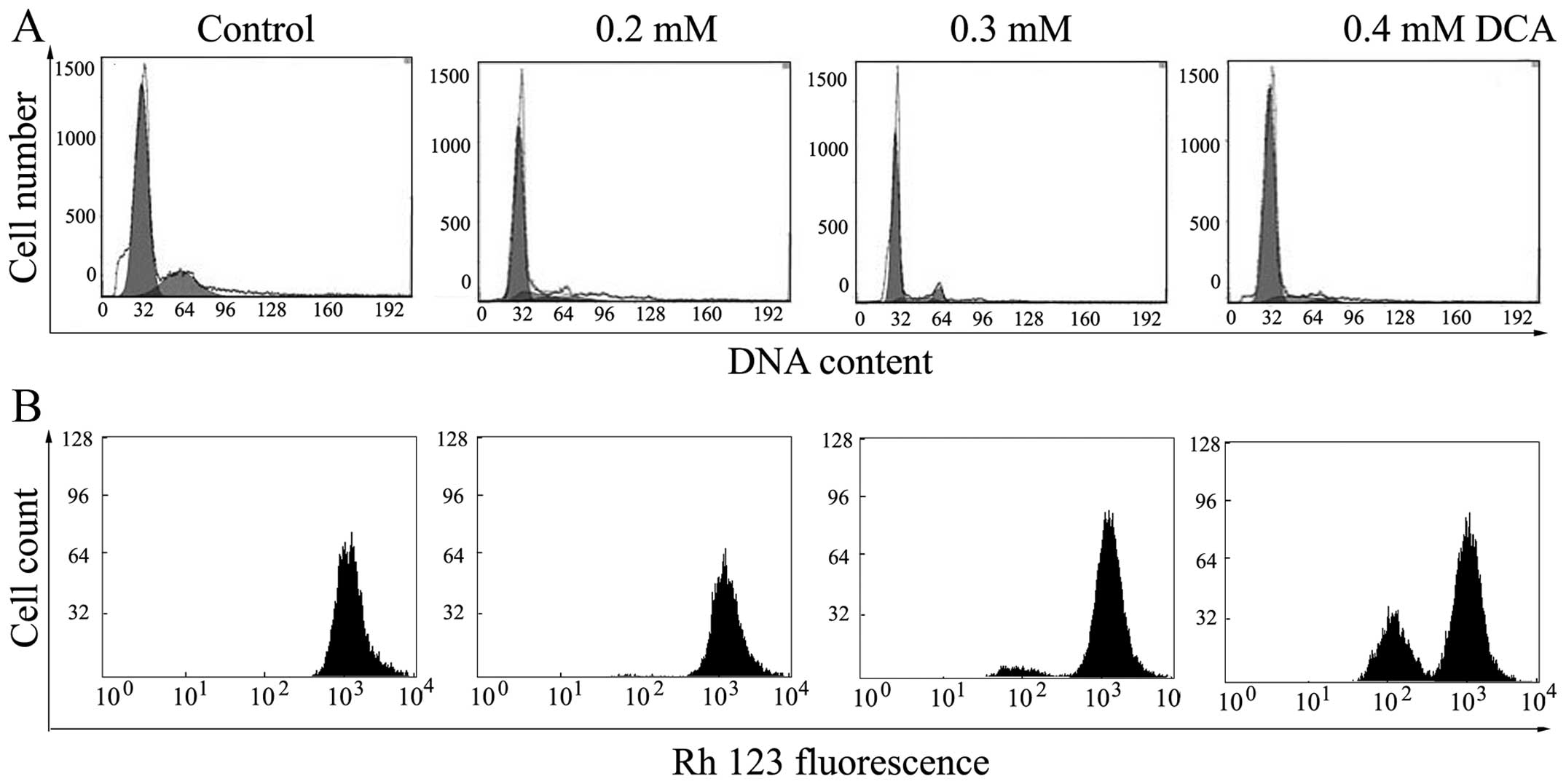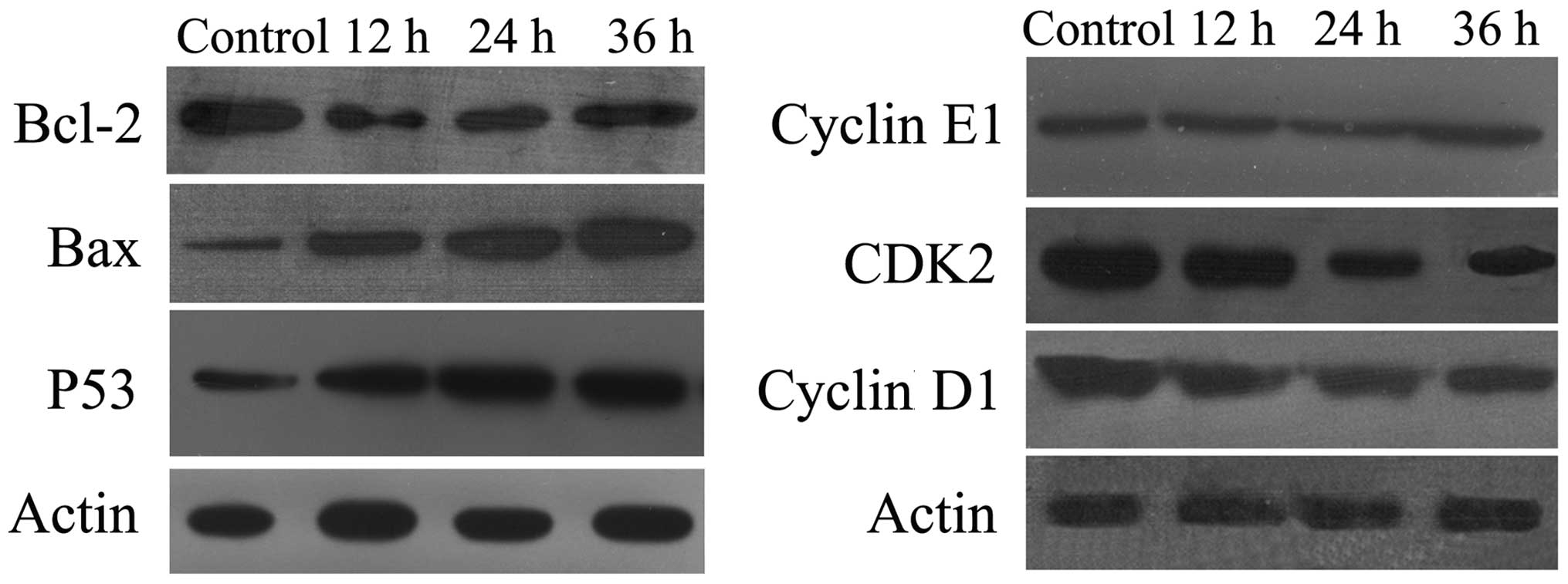Deoxycholic acid inhibits the growth of BGC-823 gastric carcinoma cells via a p53‑mediated pathway
- Authors:
- Published online on: November 26, 2014 https://doi.org/10.3892/mmr.2014.3004
- Pages: 2749-2754
Abstract
Introduction
Gastric carcinoma is a common malignant tumor of the digestive system. The morbidity and mortality of gastric cancer are the highest of any type of cancer in China (1). Surgery, chemotherapy, radiotherapy and immunotherapy are the primary methods of treatment for gastric cancer. However, the overall outcome of these therapies remains unsatisfactory (1,2). With the rapid development of tumor molecular biology and genetic engineering technology, the development of antitumor drugs has become a focus of interest in the treatment of a variety of types of cancer.
Bile acids are synthesized in the liver and secreted with the bile into the duodenum, where they perform essential functions, including the digestion and absorption of dietary lipids, and the regulation of gene expression (3–6). Previous studies have demonstrated a variety of roles for different bile acids in the treatment of cancer, depending on the nature of their chemical structures. For instance, it has been reported that certain components of bile, such as tauroursodeoxycholic acid, ursodeoxycholic acid and deoxycholic acid possess different capacities to induce apoptosis in tumor cell lines (7–10). Deoxycholic acid is a free bile acid derivative, which is composed of metabolized bile acids, and is known to promote bile secretion and to produce anti-inflammatory effects. In recent years, DCA has gained increasing attention as a potential anticarcinogenic agent. DCA has been shown to rapidly induce apoptosis in the HCT116 colon tumor cancer cell line (11,12). As a result of these studies, it was postulated that DCA may inhibit cell proliferation and induce apoptosis, and may thus be amenable to development as an antitumor agent. However, although DCA has been shown to possess anticancer properties, the mechanisms underlying these effects remain unclear. The present study aimed to assess the effects of DCA on the growth of gastric carcinoma cells by determining the ability of this compound to induce apoptosis and to explore the possible mechanisms of action.
Materials and methods
Reagents
Deoxycholic acid was obtained from Sigma-Aldrich (St. Louis, MO, USA). DCA was maintained as 100 mM stock solutions in ethanol and were stored at −20°C. DCA stock solutions were diluted to the final concentration in RPMI-1640 medium (Gibco Life Technologies, Grand Island, NY, USA), as required. 3-(4,5-Dimethylthiazol-2-yl)-2,5-diphenyl tetrazolium bromide (MTT), bisbenzimide (Hoechst 33258), acridine orange (AO), ethidium bromide (EB) and propidium iodide (PI), were purchased from Sigma-Aldrich. RPMI-1640 medium and fetal calf serum were purchased from Gibco Life Technologies (Grand Island, NY, USA). Mouse monoclonal antibodies against human p53, Bax, Bcl-2, cyclin D1, cyclin E1 and cyclin-dependent kinase (CDK)2 were obtained from Santa Cruz Biotechnology, Inc. (Dallas, TX, USA). All other chemicals used were of the highest purity grade available.
Cell lines and cell culture
The BGC-823 gastric carcinoma cell line, which was provided by the China Center for Type Culture Collection (Shanghai, China), were maintained in RPMI-1640 medium supplemented with 10% heat-inactivated fetal calf serum, 100 U/ml penicillin, 100 μg/ml streptomycin and 50 μg/ml kanamycin (Sigma-Aldrich, St. Louis, MO, USA) at 37°C in a 5% CO2 in air atmosphere. Following seeding for 24 h, cells were treated with culture medium containing various concentrations of DCA (0.2, 0.4, 0.6 or 0.8 mM).
MTT cytotoxicity assay
The cytotoxicity of DCA to the BGC823 cell line was evaluated by an MTT assay (13). Briefly, cells were arrayed in a 96-well plate at a density of 1×105/ml. Following overnight growth, cells were treated with DCA at various concentrations for 24, 48 or 72 h. Following treatment with DCA, 20 μl MTT (5 g/l) was added to each well and cells were continually cultured for another 4 h at 37°C. The medium was then removed and 150 μl dimethyl sulfoxide (DMSO; Sigma-Aldrich) was added to each well. The color intensity was measured with an ELISA microplate reader (Molecular Devices, Sunnyvale, CA, USA) at a wavelength of 490 nm.
Giemsa staining
BGC-823 cells from the control group (treated with RPMI-1640, including 0.5% DMSO) and the group treated with 0.4 mM DCA for 36 h were seeded onto cover slips and grown for 24 h. Cells were washed with phosphate-buffered saline (PBS) three times, stained with Giemsa staining solution (Sangon Biotech Co., Ltd, Shanghai, China) for 10 min and observed under a light microscope.
Hoechst 33258 and AO/EB staining
Cells that had been treated with 0.4 mM DCA for 36 h were harvested and fixed with a mixture of glacial acetic acid and methanol (1:3, v/v; Sangon Biotech Co., Ltd) for 5 min and then washed twice with PBS. Cells were resuspended in Hoechst 33258 solution (5 μg/ml) and incubated at room temperature for 10 min. Following three washes with PBS, the cells were thoroughly dried naturally at room temperature and observed under a fluorescence microscope (Eclipse Te2000-E; Nikon Corp., Tokyo, Japan). For AO/EB staining, the cells were harvested and washed twice with PBS. Cells were then incubated with 100 μl PBS plus 4 μl AO/EB solution (100 μg/ml AO and 100 μg/ml EB in PBS) for 3 min at room temperature in darkness and immediately observed under a fluorescence microscope.
Flow cytometry
Following treatment with DCA at different concentrations (0.2, 0.4, 0.6 and 0.8 mM) for 36 h, the BGC-823 cells were harvested, washed twice with PBS and fixed with 70% ethanol at 4°C overnight. Cells were then centrifuged at 800 × g for 5 min, resuspended in 100 μg/ml RNase A (Sigma-Aldrich) at 37°C for 30 min and stained with 50 μg/ml propidium iodide at 4°C for 30 min in darkness. Cells were analyzed by flow cytometry (Guava easyCyte 8; EMD Millipore, Billerica, MA, USA) at 488 nm, and the data were analyzed with CellFit software (Guava InCyte; EMD Millipore).
Analysis of mitochondrial transmembrane potential (ΔΨm)
Following treatment with various concentrations of DCA (0.2, 0.3, 0.4 and 0.5 mM) for 48 h, the BGC-823 cells were incubated with Rh123 (1 mg/ml in DMSO; Sigma-Aldrich) at 37°C for 30 min and washed three times with PBS. Cells were then harvested and analyzed by flow cytometry at an excitation wavelength of 488 nm and an emission wavelength of 530 nm.
Western blotting analysis
Western blotting analysis was performed as previously described (13). Briefly, cell lysates were prepared, separated with 12% SDS-PAGE and transferred onto polyvinylidene fluoride membranes (Amersham Biosciences, Piscataway, NJ, USA). Non-specific reactivity was blocked by incubating the membranes for 1 h in 5% nonfat milk at room temperature. The membranes were incubated with primary antibody overnight at 4°C. After three washes for 10 min with phosphate-buffered saline Tween-20 (PBST), the membranes were incubated at 37 °C for 1 h with the appropriate secondary antibody (1:5,000; Sigma-Aldrich) and washed three times with PBST. Reactive proteins were detected with an enhanced chemiluminescence detection system (Pierce Biotechnology Inc., Rockford, IL, USA). β-actin was used as an internal control.
Statistical analysis
Data were analyzed using SPSS software, version 13.0 (SPSS, Inc., Chicago, IL, USA). Data are expressed as the mean ± standard error of the mean of separate experiments (n≥3). P<0.05 was considered to indicate a statistically significant difference.
Results
Effects of DCA on the proliferation of BGC-823 cells
With DCA concentrations of 0.2, 0.4, 0.6 and 0.8 mM, the proliferation of BGC-823 cells was significantly inhibited in a dose- and time-dependent manner. Following treatment with various concentrations of DCA the percentage of inhibition at 24 h were 7.89, 10.12, 25.56 and 40.12%, and at 48 h were 34.09, 55.22, 79.21 and 95.02%, with doses of 0.2, 04.4, 0.6 and 0.8 mM DCA, respectively (Fig. 1).
Morphological changes of BGC-823 cells following DCA treatment
Hoechst 33258 staining showed that the nuclei of cells in the control group exhibited a uniform dispersion of low-intensity fluorescence and had an integral structure. However, following treatment with 0.3 mM DCA, the nuclei exhibited pyknosis or a granular distribution of fluorescence. In these cells, the intensity of fluorescence was uneven and the nuclei appeared deformed and horseshoe-shaped, in addition to other typical characteristics of apoptosis, including condensed chromatin, gradual disintegration of the nuclear membrane, and pyknotic (shrunken and dark) nuclei (Fig. 2). The results of the AO/EB staining demonstrated that the control BGC-823 cells appeared uniformly green, and contained nuclei with apparently normal structures. However, the DCA-treated cells appeared orange or red, the nuclei exhibited pyknosis and there was cataclastic scattering (non-uniform fluorescence distribution) in the cytoplasm.
Following Giemsa staining, BGC-823 cells exhibited various morphological forms, such as epithelioid, round, and irregular. When treated with a concentration of 0.3 mM DCA, BGC-823 cells were observed to undergo a significant morphological change and appeared shrunken, with a small nucleus and chromatin agglutination. Apoptotic cells were observed singly or in groups.
Flow cytometric analysis
Cell cycle progression in the BGC-823 cells was analyzed using flow cytometry. The results showed that the cell cycle distribution of BGC-823 cells changed markedly following treatment with various concentrations of DCA (0.2, 0.3, 0.4 and 0.5 mM). The proportion of cells in G0/G1 phase in the control group was 60.12, which increased to 88.35% following treatment with 0.3 mM DCA, while the proportion of cells at G2 phase decreased significantly from 25.16 to 4.98%. These results indicate that the cell cycle was arrested in G0/G1 phase following treatment with DCA.
Analysis of ΔΨm
In order to explore whether mitochondrial damage is involved in DCA-induced apoptosis, the increase of Rh123 hyperfluorescence that occurs with a decrease in membrane potential, was used to investigate the changes in ΔΨm following treatment with DCA. As shown in Fig. 3B, a significant dose-dependent increase in the mean fluorescence intensity of the cells, associated with collapse of the ΔΨm, were observed in the BGC-823 cells following 48 h of treatment with DCA.
Western blot analysis
To investigate the mechanisms underlying the induction of apoptosis in BGC-823 cells by DCA, the levels of expression of apoptosis-related proteins, including p53, Bax, Bcl-2, CKD2, Cyclin D1 and Cyclin E1 were measured. The tumor-suppressor protein, p53, regulates apoptosis through the transcriptional activation of its target genes, and acts as a key facilitator of cross-talk between numerous pathways. Following treatment with DCA, the level of the p53 protein was significantly increased (Fig. 4A). As the proteins of the Bcl-2 family are known to regulate the mitochondrial pathway by controlling the permeability of the outer mitochondrial membrane during apoptosis, the effect of DCA on the expression of Bcl-2 and Bax was investigated. As shown in Fig. 4A, following exposure to DCA for 48 h, Bcl-2 expression was diminished while Bax expression was elevated. Therefore, the Bcl-2:Bax ratio was markedly decreased in DCA-treated BGC-823 cells. Furthermore, the levels of cyclin D1 and CDK2 decreased in DCA-treated BGC-823 cells in a dose-dependent manner (Fig. 4B). These results suggest that p53 is involved in the induction of apoptosis by DCA.
Discussion
Over recent years, it has been shown that DCA induces apoptosis in a number of types of human malignancies (14,15). The results from the present study indicated that DCA significantly inhibits the proliferation of BGC-823 cells in a dose-dependent manner and induces apoptosis via activation of the mitochondrial pathway. p53 was also shown to be involved in the DCA-mediated apoptosis of BGC-823 cells.
Apoptosis was initially described according to its morphological characteristics, and morphology remains a relevant experimental method to demonstrate the occurrence of this process. Morphological features characteristic of apoptosis were observed in BGC-823 cells following exposure to DCA, including cell shrinkage, chromatin agglutination, marginalization, nuclear fragmentation and apoptotic body formation. An important feature of apoptosis is the permeabilization of mitochondria. Mitochondria are known to be an important part of apoptotic signaling. DCA treatment led to a concentration-dependent reduction in mitochondrial membrane potential. This drop in ΔΨm produces changes in mitochondrial biogenesis and activity, decreasing the numbers of mitochondria and influencing the stability of mitochondrial function.
There are several checkpoints during the cell cycle. The most important points are the G1/S phase transition and the G2/M phase transition. Healthy cells replicate during S phase and reduce in number during G1 phase. By contrast, tumor cells are able to bypass the checkpoint of the G1/S and G2/M phase transition points, allowing cells to proliferate without restraint. Therefore, the genes controlling the G1/S or G2/M phase transitions are potential targets for the development of antitumor drugs (16). To determine whether the toxicity of DCA in BGC-823 cells is due to the induction of cell cycle arrest, the cell cycle phase distribution of the treated cells was examined by flow cytometry. The results showed that BGC-823 cells were arrested at the G1 phase when treated with DCA. The ratio of cells in the G1 phase was positively correlated with the duration and concentration of DCA administered, which indicates that the inhibition of gastric cancer cell growth by DCA may be due to G1 phase arrest. Furthermore, following treatment of BGC-823 cells with DCA, the expression of Cyclin D1 and CDK2 proteins was downregulated.
The mechanism underlying DCA-induced apoptosis in BGC-823 cells is unclear. The intrinsic apoptosis pathway is a mitochondrial-mediated cell death process, which is regulated by the Bcl-2 family of proteins that comprises proapoptotic proteins, such as Bax, Bak, Bad and Bid, and antiapoptotic proteins, such as Bcl-2 and Bcl-XL. Activation of the intrinsic pathway is often associated with a change in the level of Bax:Bcl-2 expression or the ratio of these proteins (17). In the present study, the expression of Bax was shown to be upregulated, while the expression of Bcl-2 was downregulated. The ratio of Bax:Bcl-2 was increased. This rise in the Bax:Bcl-2 ratio suggested a commitment of BGC-823 cells to apoptosis via activation of the mitochondria-dependent pathway.
A study demonstrated that almost 50% of human tumors carry p53 mutations, and that additional mechanisms are able to disrupt wild-type p53 function (18). Although a number of studies have shown that apoptosis may be induced in a p53-independent manner (19–26), other studies have reported that p53 is actively required for apoptosis to occur (24,27,28). The action of p53 has been shown to operate predominantly through induction of apoptosis in cells via the intrinsic pathway (29,30). Therefore, it is important to further investigate this process and to identify whether the activation of p53 is involved in the mechanisms underlying the induction of apoptosis in BGC-823 cells. The results from the current study demonstrated that p53 was active during DCA-induced apoptosis, and suggested that P53 may have a central role in the apoptosis of BGC-823 cells.
In conclusion, the present study demonstrated that DCA significantly inhibited proliferation and arrested cell cycle progression at the G0/G1 phase in BGC-823 cells. The results indicated that DCA-induced apoptosis of BGC-823 cells occurs via activation of the mitochondrial pathway, in which p53 is involved. An improved understanding of the way in which DCA regulates cell death may provide insight into potential anticancer mechanisms, and aid in the selection of novel natural compounds for screening and ultimately the development of cancer treatments.
Acknowledgements
This work was supported by grants from National Natural Science Foundation of China (81402309); Foundation of Henan Educational Committee (13A180044); and Henan Planning Project of Science and Technology (132102310118).
References
|
Baan R, Grosse Y, Straif K, et al: A review of human carcinogens-part F: chemical agents and related occupations. Lancet Oncol. 10:1143–1144. 2009. View Article : Google Scholar : PubMed/NCBI | |
|
El Ghissassi F, Baan R, Straif K, et al: A review of human carcinogens-part D: radiation. Lancet Oncol. 10:751–752. 2009. View Article : Google Scholar : PubMed/NCBI | |
|
Tsai HC, Lin FC, Chen YC and Chang SC: The role of total bile acid in oral secretions in ventilator-associated pneumonia. J Crit Care. 27:526 e1–e6. 2012. View Article : Google Scholar | |
|
Charach G, Rabinovich A, Argov O, Weintraub M and Rabinovich P: The role of bile acid excretion in atherosclerotic coronary artery disease. Int J Vasc Med. 2012:9496722012. | |
|
Park WI, Park MJ, An JK, et al: Bile acid regulates c-jun expression through the orphan nuclear receptor SHP induction in gastric cells. Biochem Biophys Res Commun. 369:437–443. 2008. View Article : Google Scholar : PubMed/NCBI | |
|
Keitel V, Donner M, Winandy S, Kubitz R and Haussinger D: Expression and function of the bile acid receptor TGR5 in kupffer cells. Biochem Biophys Res Commun. 372:78–84. 2008. View Article : Google Scholar : PubMed/NCBI | |
|
Krishna-Subramanian S, Hanski ML, Loddenkemper C, et al: UDCA slows down intestinal cell proliferation by inducing high and sustained ERK phosphorylation. Int J Cancer. 130:2771–2782. 2012. View Article : Google Scholar | |
|
Dosa PI, Ward T, Castro RE, Rodrigues CM and Steer CJ: Synthesis and evaluation of water-soluble prodrugs of ursodeoxycholic acid (UDCA), an anti-apoptotic bile acid. Chem Med Chem. 8:1002–1011. 2013. View Article : Google Scholar : PubMed/NCBI | |
|
Zheng MF, Shen SY and Huang WD: DCA increases the antitumor effects of capecitabine in a mouse B16 melanoma allograft and a human non-small cell lung cancer A549 xenograft. Cancer Chemother Pharmacol. 72:1031–1041. 2013. View Article : Google Scholar : PubMed/NCBI | |
|
Ha YH and Park DG: Effects of DCA on cell cycle proteins in colonocytes. J Korean Soc Coloproctol. 26:254–259. 2010. View Article : Google Scholar : PubMed/NCBI | |
|
Zeng H, Botnen JH and Briske-Anderson M: Deoxycholic acid and selenium metabolite methylselenol exert common and distinct effects on cell cycle, apoptosis, and MAP kinase pathway in HCT116 human colon cancer cells. Nutr Cancer. 62:85–92. 2010. View Article : Google Scholar : PubMed/NCBI | |
|
Yui S, Kanamoto R and Saeki T: Deoxycholic acid can induce apoptosis in the human colon cancer cell line HCT116 in the absence of Bax. Nutr Cancer. 60:91–96. 2008. View Article : Google Scholar : PubMed/NCBI | |
|
Song W, Shen DY, Kang JH, et al: Apoptosis of human cholangiocarcinoma cells induced by ESC-3 from Crocodylus siamensis bile. World J Gastroenterol. 18:704–711. 2012. View Article : Google Scholar : PubMed/NCBI | |
|
Ignacio Barrasa J, Olmo N, Perez-Ramos P, et al: Deoxycholic and chenodeoxycholic bile acids induce apoptosis via oxidative stress in human colon adenocarcinoma cells. Apoptosis. 16:1054–1067. 2011. View Article : Google Scholar : PubMed/NCBI | |
|
Higuchi H, Bronk SF, Takikawa Y, et al: The bile acid glycochenodeoxycholate induces trail-receptor 2/DR5 expression and apoptosis. J Biol Chem. 276:38610–38618. 2001. View Article : Google Scholar : PubMed/NCBI | |
|
Zhao X, Yang W, Shi C, et al: The G1 phase arrest and apoptosis by intrinsic pathway induced by valproic acid inhibit proliferation of BGC-823 gastric carcinoma cells. Tumour Biol. 32:335–346. 2011. View Article : Google Scholar | |
|
Gao LW, Zhang J, Yang WH, Wang B and Wang JW: Glaucocalyxin A induces apoptosis in human leukemia HL-60 cells through mitochondria-mediated death pathway. Toxicology in vitro. 25:51–63. 2011. View Article : Google Scholar | |
|
Wiman KG: Strategies for therapeutic targeting of the p53 pathway in cancer. Cell Death Differ. 13:921–926. 2006. View Article : Google Scholar : PubMed/NCBI | |
|
Zhang X, Jiang Y and Yang J: p53-independent signaling pathway in DNA damage-induced cell apoptosis. Zhejiang Da Xue Xue Bao Yi Xue Ban. 42:217–223. 2013.(In Chinese). PubMed/NCBI | |
|
Yerlikaya A, Okur E and Ulukaya E: The p53-independent induction of apoptosis in breast cancer cells in response to proteasome inhibitor bortezomib. Tumour Biol. 33:1385–1392. 2012. View Article : Google Scholar : PubMed/NCBI | |
|
Abeysinghe RD, Greene BT, Haynes R, et al: p53-independent apoptosis mediated by tachpyridine, an anti-cancer iron chelator. Carcinogenesis. 22:1607–1614. 2001. View Article : Google Scholar : PubMed/NCBI | |
|
Arita D, Kambe M, Ishioka C and Kanamaru R: Induction of p53-independent apoptosis associated with G2M arrest following DNA damage in human colon cancer cell lines. Jpn J Cancer Res. 88:39–43. 1997. View Article : Google Scholar : PubMed/NCBI | |
|
Cattaneo-Pangrazzi RM, Schott H, Wunderli-Allenspach H, Rothen-Rutishauser B, Guenthert M and Schwendener RA: Cell-cycle arrest and p53-independent induction of apoptosis in vitro by the new anticancer drugs 5-FdUrd-P-FdCydOct and dCydPam-P-FdUrd in DU-145 human prostate cancer cells. J Cancer Res Clin Oncol. 126:247–256. 2000. View Article : Google Scholar : PubMed/NCBI | |
|
Miyake N, Chikumi H, Takata M, Nakamoto M, Igishi T and Shimizu E: Rapamycin induces p53-independent apoptosis through the mitochondrial pathway in non-small cell lung cancer cells. Oncol Rep. 28:848–854. 2012.PubMed/NCBI | |
|
Aimola P, Carmignani M, Volpe AR, et al: Cadmium induces p53-dependent apoptosis in human prostate epithelial cells. PLoS One. 7:e336472012. View Article : Google Scholar : PubMed/NCBI | |
|
Watson JL, Hill R, Yaffe PB, et al: Curcumin causes superoxide anion production and p53-independent apoptosis in human colon cancer cells. Cancer Lett. 297:1–8. 2010. View Article : Google Scholar : PubMed/NCBI | |
|
Saha S, Hossain DM, Mukherjee S, et al: Calcarea carbonica induces apoptosis in cancer cells in p53-dependent manner via an immuno-modulatory circuit. BMC Complement Altern Med. 13:2302013. View Article : Google Scholar : PubMed/NCBI | |
|
Hoeferlin LA, Fekry B, Ogretmen B, Krupenko SA and Krupenko NI: Folate stress induces apoptosis via p53-dependent de novo ceramide synthesis and up-regulation of ceramide synthase 6. J Biol Chem. 288:12880–12890. 2013. View Article : Google Scholar : PubMed/NCBI | |
|
Sznarkowska A, Olszewski R and Zawacka-Pankau J: Pharmacological activation of tumor suppressor, wild-type p53 as a promising strategy to fight cancer. Postepy Hig Med Dosw (Online). 64:396–407. 2010.(In Polish). | |
|
Jedrych M, Wawryk-Gawda E, Jodlowska-Jedrych B, Chylinska-Wrzos P and Jasinski L: Immunohistochemical evaluation of cell proliferation and apoptosis markers in ovarian surface epithelial cells of cladribine-treated rats. Protoplasm. 250:1025–1034. 2013. View Article : Google Scholar |













